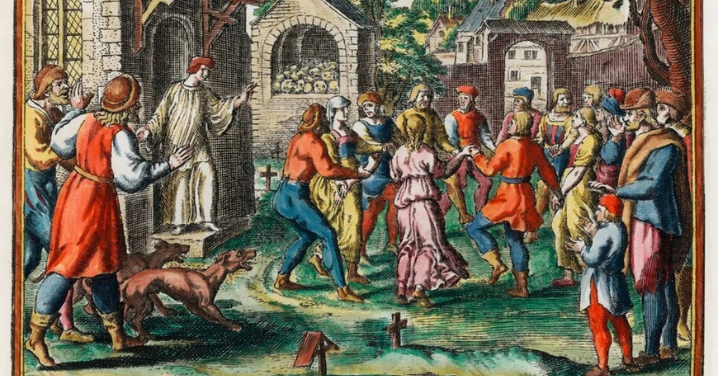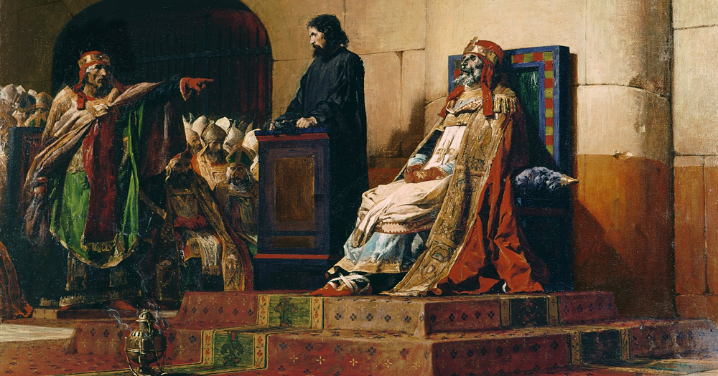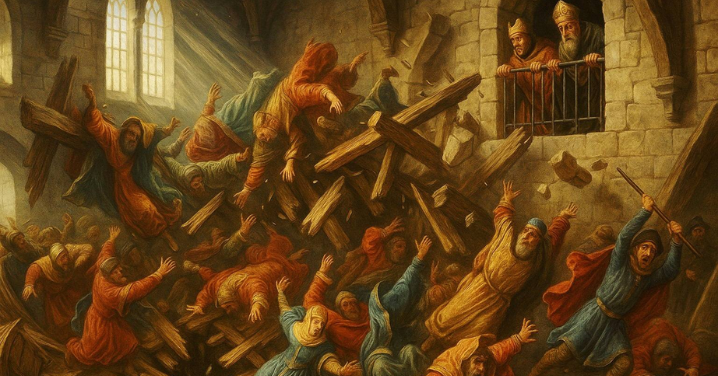
If you have ever woken up after a night out and thought “wow I danced so hard I nearly died,” spare a thought for the poor souls of Strasbourg in the summer of 1518 who literally danced themselves to death. Yes, that is a sentence that sounds like it should be part of a Monty Python sketch or the backstory to a dark fairytale, but it actually happened. Hundreds of people were swept up in what became known as the Dancing Plague, an outbreak of uncontrollable movement that had men and women twirling, stomping, shaking and collapsing until their bodies simply gave out. Forget raves, forget music festivals, forget TikTok trends. Medieval Europe delivered the deadliest dance floor of all time, and it was every bit as bizarre as it sounds.
The whole thing started with a single woman. Her name was Frau Troffea, a local resident of Strasbourg, which at the time was part of the Holy Roman Empire. One hot July morning she walked into the street and began to dance. Not gracefully, not for fun, but with a strange mechanical energy that made it look like her body was in charge while her mind had checked out. People laughed at first. It looked absurd. But she did not stop. Hours went by. Then days. She danced until her feet bled and she collapsed, only to get back up and keep moving. Within a week more than thirty other residents had joined her, all seemingly possessed by the same uncontrollable rhythm. Within a month the number grew to around four hundred. Four hundred people moving without music, without reason, driven by something nobody could explain.
The authorities were baffled. The local council and clergy assumed it must be some kind of illness or curse. Their solution, naturally, was to lean into the madness. Instead of quarantining people they decided to encourage the dancers to wear themselves out. They even hired musicians and brought in professional dancers to “help” the afflicted purge whatever was inside them. Imagine hundreds of exhausted, bleeding, half delirious townsfolk forced into medieval Zumba classes with live musicians cheering them on. It was meant as a cure. It was, of course, a disaster.
People collapsed from exhaustion. Some broke bones. Others quite literally died from heart attacks and strokes brought on by days of relentless motion. Eyewitnesses described scenes that sound like something from a horror film. Men foaming at the mouth, women spinning until they hit the ground, children joining in only to collapse beside their parents. There was no music festival magic here. There was only the sound of bodies hitting cobblestones, groans of pain, and the relentless shuffle of feet that refused to stop. Strasbourg became a nightmare dance floor with no DJ and no off switch.
So what actually caused it? Historians still argue about it. Some believe it was a case of mass hysteria, also known as psychogenic illness, where social stress and fear spread physically through communities. Strasbourg at the time was dealing with famine, disease and deep religious anxiety. The people were primed for collective breakdown. When Frau Troffea began her dance, others may have unconsciously mirrored her in a kind of social chain reaction, until hundreds were swept up. Others think it was ergot poisoning, caused by a fungus that grows on damp rye bread and produces LSD-like effects. Hallucinations, spasms, convulsions, it all fits. The only problem is that ergot usually makes people collapse, not dance for weeks, so the theory is shaky. Another theory is that it was a religious ritual gone horribly wrong, some kind of local penitence or ecstatic tradition that spiralled beyond control. The truth is nobody knows for certain, and maybe we never will. Which almost makes it worse, because the ambiguity keeps it unsettling.
The story is often told like a quirky curiosity, but when you stop to think about it, it is genuinely horrific. Hundreds of people trapped in bodies that refused to stop moving, driven into exhaustion, pain and death. Families would have watched loved ones crumble, neighbours would have avoided the streets, and the city must have smelled of sweat and blood in the summer heat. Imagine trying to run your bakery or your blacksmith shop while people collapsed outside your door in the middle of endless dancing. Imagine trying to explain to your children why the adults down the road were writhing in agony while a hired band played lute music to “cure” them. It was surreal and terrifying.
Of course, the symbolism writes itself. The people of Strasbourg were crushed by famine and poverty, and when they finally broke it came out as a grotesque parody of joy. They danced because they could not scream. They danced because they could not fix the world around them. They danced until their bodies gave out. It was a rebellion against suffering, but one that killed the rebels. The fact that the city officials responded by making it into a bigger dance only adds another layer of absurdity. It is like treating a fire with more matches. Medieval logic was never the sharpest tool in the shed, and this event is one of the best examples.
What makes the Dancing Plague so unforgettable is how modern it feels. Mass hysteria is not a relic of the past. We still see waves of strange behaviour ripple through society. Social media challenges that leave people in hospital, financial panics that spread like wildfire, moral frenzies that sweep entire communities. Humans are social creatures. We mirror one another. Sometimes that creates beautiful acts of solidarity. Sometimes it creates four hundred people dancing themselves to death. If Strasbourg had TikTok in 1518, the hashtag would have gone viral, the algorithms would have rewarded it, and people would still be reposting shaky footage of it today.
The Dancing Plague also shows how thin the line is between joy and horror. Dancing is supposed to be a celebration, a release, a way of connecting with others. To see it twisted into something fatal is unnerving. It is the equivalent of laughing until you choke or feasting until you starve. It takes something life affirming and turns it inside out. No wonder the story has echoed for centuries. It touches a primal nerve.
And while it seems absurd now, it is worth remembering that the people of Strasbourg did not laugh. For them it was not a quirky tale to tell tourists or a meme to share online. It was death, confusion and fear. The city only managed to stop it by eventually marching the remaining dancers out of Strasbourg to a shrine dedicated to Saint Vitus, the patron saint of dancing, where priests prayed over them until the outbreak finally ended. It had lasted weeks. By then, dozens had died. The survivors carried scars that were not just physical. You do not forget the summer when your city turned into a deadly dance floor.
The Dancing Plague of 1518 deserves its place in the hall of weird history right alongside the Erfurt Latrine Disaster. Both are absurd, grotesque and darkly comic. Both reveal how fragile humans really are. One minute you are a noble boasting in armour, the next you are drowning in filth. One minute you are a housewife in Strasbourg, the next you are stomping yourself into an early grave. History is not a straight line of noble deeds. It is a mess of accidents, absurdities and tragedies that look like satire. And that is exactly why stories like this stick.
So next time you complain about getting dragged to a wedding dance floor or suffering through a Zumba class, remember Strasbourg. Remember Frau Troffea and the hundreds who followed her. Remember the city that turned into the world’s deadliest rave with no music and no end. And maybe appreciate that when you finally decide to stop dancing, you actually can. Because for the poor souls of 1518, there was no off button, and their legacy is one of the strangest, darkest stories ever to shuffle across the pages of history.



